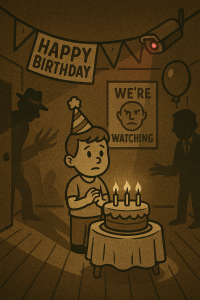Atmosphere of Threat: The “Great Reset” conspiracy theory and climate change denial
Kainan Jarrette and Nina Kotova
Atmosphere of Threat: The “Great Reset” Conspiracy Theory and Climate Change Denial
Learning Objectives
- Describe the tactics content creators can use to create worry and fear in a viewer
- Define “The Great Reset” conspiracy theory
- Describe research-based criticisms of the real “Great Reset Initiative”
Introduction

We analyzed a short video uploaded to Tiktok, titled “The Great Reset explained”. Published on February 28, 2022, the video is based on the conspiracy theory of the formation of a “New World Order” that will attempt to infuse chaos into the global economy. In reality, “The Great Reset” is a global initiative for sustainable economic recovery in the midst of the COVID-19 pandemic. It was launched by the World Economic Forum (WEF) in June 2020, and amplified by WEF President Klaus Schwab (The Great Reset, 2022). The underlying idea of the initiative is that the world needs to be more prepared for harmful global phenomenon, be it a pandemic or the growing effects of climate change. Because this initiative was interested in global economics, it quickly became a target of “New World Order” conspiracy theorists. The assertion was that global elites would use radical policies such as forced vaccinations, universal digital ID cards, transaction monitoring, and even renunciation of private property to destroy global capitalism an enact a singular “one-world” government, or “New World Order.” Of course, nothing even close to this exists in the actual initiative, nor is any direct evidence given for any of these claims.
The video is another good piece of example material, as it uses various misinformation strategies and tactics, which we’ll discuss below.
Key Questions
- How can fear be used to influence one’s thinking in the context of media literacy?
Immersive Strategies and Tactics
Section 1.1: Atmosphere of Threat
One primary strategy used in the video is creating an atmosphere of threat. This is a misinformation strategy that emphasizes eliciting feelings of fear and anxiety in the audience. In the video, this is accomplished through two primary tactics: appeal to emotion and appeal to consequences.
Appeal to emotion is an informal fallacy characterized by the manipulation of the recipient’s emotions in order to win an argument, especially in the absence of factual evidence. Broadly speaking, emotions can be manipulated in a variety of ways; but in this video, they’re primarily manipulated through a combination of ominous music and emotional language. This language is seen in words and phrases like:
-
- “touted by psychopaths”
- “crash the world economy”
- “a world government dictating”
- “I was staggered”
- “going through the roof”
- “global economic chaos”
- “turmoil and desperation”
Appeal to consequences – a fallacious argument that concludes a belief is either true or false based on whether the premise leads to desirable or undesirable consequences. In the video, the repeated assertion is that the consequence of a “New World Order” is the collapse of the global economy and the loss of individual freedom. This outcome is so undesirable to most people that they may start to give credence to the argument out of a desire to avoid that outcome.
Ultimately, the idea is to cultivate a sense of dread and anxiety that permeates throughout the entire video, giving emotional weight to what’s being said. Many viewers will focus on the feeling over the content, which is exactly the point.

Section 1.2: Believable Villain Narratives
A second major strategy is creating a believable villain narrative. As its name suggests, it’s a storytelling tool. It involves not only broadly villainizing the opposing side, but choosing specific people to unwillingly act as representatives of the greater villainous whole. Villainizing is fleshed out through attributing specific beliefs, desires, and motivations to the specific villains. All of this is accomplished through several tactics:
Ad hominem attacks – simply put, this is when you attack the speaker instead of the argument. It’s an incredibly common tactic, and can be seen in the video with specifically personal statements such as “psychopaths like Klaus Schwab.” The primary issue is that they are subjective, aggressive statements that have no logical relation to the actual argument at hand.
Although not a requirement, ad hominem attacks can often create circular reasoning, or arguments that come back to their beginning without having actually proven anything. Written out, the argument of the video could be summarized like this:
-
-
- Assertion: Klaus Schwab is a psychopath.
- Question: What evidence is there that Klaus Schwab is a psychopath?
- Assertion: Klaus Schwab is a psychopath because he wants to collapse the world economy.
- Question: What evidence is there that Klaus Schwab wants to collapse the world economy?
- Assertion: Klaus Schwab wants to collapse the world economy because he is a psychopath.
-
Misquotation – when a quote has its content changed, is taken out of context, or is falsely attributed. While this is often used fairly directly, by simply saying someone said something they didn’t, in the video there’s a particularly interesting use of misquotation that works in conjunction with the next tactic:
False documentary style – this is the practice of presenting subjective propaganda as objective documentation (Bond, 2022). Culturally, we tend to extend a certain amount of trust to people that present themselves as legitimate documentarians. But that trust can be misused to lend credibility to illogical, inaccurate, or harmful ideas. In the video, for instance, the audio is taken from an interview with notorious conspiracy theorist David Icke (progenitor of the “lizard people” conspiracy theory), but Icke is never shown or referenced. David Icke has a specific and proven reputation for being an unreliable source, yet here his statements are lent false credibility simply through not actually attributing them to their author.
Half-truths – using a truthful component of an issue or argument out of context to support false assertions or information. In the video, this can be seen in statements like “There will be no cash, which means every transaction is trackable.” There’s an element of truth in there, insofar as it’s certainly easier to track digital transactions than cash transactions. However, no evidence is provided for the pretty serious inference that the initiative will somehow lead to abolishing all cash.
Although these tactics can be commonly found in disinformation, it should be noted that they don’t inherently invalidate every component of an argument. For instance, despite his track record, the fact that an argument is coming from David Icke does not immediately invalidate it (although the authors wouldn’t likely bet against that odd in Vegas). What’s important is that these tactics not only appear, but appear in the absence of any real evidence.

The Truth About the Great Reset
The World Economic Forum’s Great Reset Initiative is an approach to global cooperation for economic recovery, which you can read about here. You don’t have to agree with every (or any) aspect of the initiative to disagree with the validity of the conclusions and assertions in the video. In fact, there are certainly evidence-based critiques of the initiative, such as the worry that it gives capitalist stakeholders power that should be in the hands of expert agencies like the World Health Organization (WHO). Rational, logical debate on the merits of an idea is necessary and healthy. Videos like “The Great Reset Explained” may pose as that, but ultimately deal only in inferences for which there is no evidence or rational thought process. Regardless, this type of misinformation can easily be spread, and may be many viewers first experience of the Great Reset initiative.
Key Terms
a power technique where, instead of responding to the logic of the argument itself, a speaker attacks the person making the argument, focusing on personal qualities that have nothing to do with the argument in question
a fallacious argument that concludes a belief is either true or false based on whether the premise leads to desirable or undesirable consequences
an informal fallacy characterized by the manipulation of the recipient’s emotions in order to win an argument, especially in the absence of factual evidence
atmosphere of threat
a misinformation strategy that emphasizes tactics that elicit fear and anxiety
a disinformation strategy that emphasizes tactics that villainize the motivations and proponents of an idea
arguments that come back to their beginning without having actually proven anything
an explanation for an event or situation that asserts the existence of a secret plan by powerful and sinister groups
the use of language calculated to create a strong emotional reaction in the listener
the practice of presenting subjective propaganda as objective documentation
using a truthful component of an issue or argument out of context to support false assertions or information
when a quote has its content changed, is taken out of context, or is falsely attributed
References
Arp, R., Barbone, S., & Bruce, M. (Eds.). (2018). Bad Arguments: 100 of the Most Important Fallacies in Western Philosophy (1st edition). Wiley-Blackwell.
Bond, S. (2022, November 3). How documentary-style films turn conspiracy theories into a call to action. NPR. https://www.npr.org/2022/11/03/1133686674/how-documentary-style-films-turn-conspiracy-theories-into-a-call-to-action
Corporation, I. (2022). Davos Forum 2022: Government Policies and Business Strategies. Iberdrola. https://www.iberdrola.com/about-us/iberdrola-world-economic-forum-davos
Hsu, T. (2022, November 4). Worries Grow That TikTok Is New Home for Manipulated Video and Photos. The New York Times. https://www.nytimes.com/2022/11/04/technology/tiktok-deepfakes-disinformation.html
Nash, K. (2022). Deepfakes, Documentary and the Dead: “I Wasn’t Putting Words into His Mouth. I Was Just Trying to Make Them Come Alive.” Journal of Media Ethics, 0(0), 1–2. https://doi.org/10.1080/23736992.2022.2118124
Slobodian, Q. (2020, December 4). How the “great reset” of capitalism became an anti-lockdown conspiracy. The Guardian. https://www.theguardian.com/commentisfree/2020/dec/04/great-reset-capitalism-became-anti-lockdown-conspiracy
The Great Reset. (2022). World Economic Forum. https://www.weforum.org/great-reset/
The Great Reset: What is it? (2022). Full Fact. https://fullfact.org/online/great-reset-conspiracy-theory/
Walton, D., & Macagno, F. (2011). Quotations and Presumptions: Dialogical Effects of Misquotations. Informal Logic, 31(1), Article 1. https://doi.org/10.22329/il.v31i1.657
Media Attributions
- Atmosphere of Threat
- Tiny_Lizard_-_Mid-City_New_Orleans © Bart Everson is licensed under a CC BY-SA (Attribution ShareAlike) license
an explanation for an event or situation that asserts the existence of a secret plan by powerful and sinister groups
a misinformation strategy that emphasizes tactics that elicit fear and anxiety
an informal fallacy characterized by the manipulation of the recipient's emotions in order to win an argument, especially in the absence of factual evidence
the use of language calculated to create a strong emotional reaction in the listener
a fallacious argument that concludes a belief to be either true or false based on whether the premise leads to desirable or undesirable consequences
a disinformation strategy that emphasizes tactics that villainize the motivations and proponents of an idea
a power technique where, instead of responding to the logic of the argument itself, a speaker attacks the person making the argument, focusing on personal qualities that have nothing to do with the argument (From Reinhardt et al, 2023)
when a quote has its content changed, is taken out of context, or is falsely attributed
when a piece of propaganda (usually video) portrays itself as objective documentation
misinformation that contains a truthful component of an issue or argument out of context, to support false assertions or information
arguments that come back to their beginning without having actually proven anything

